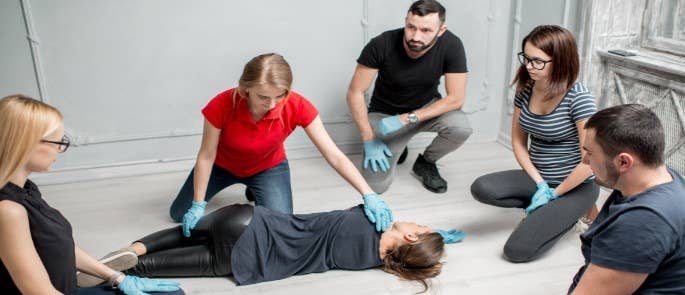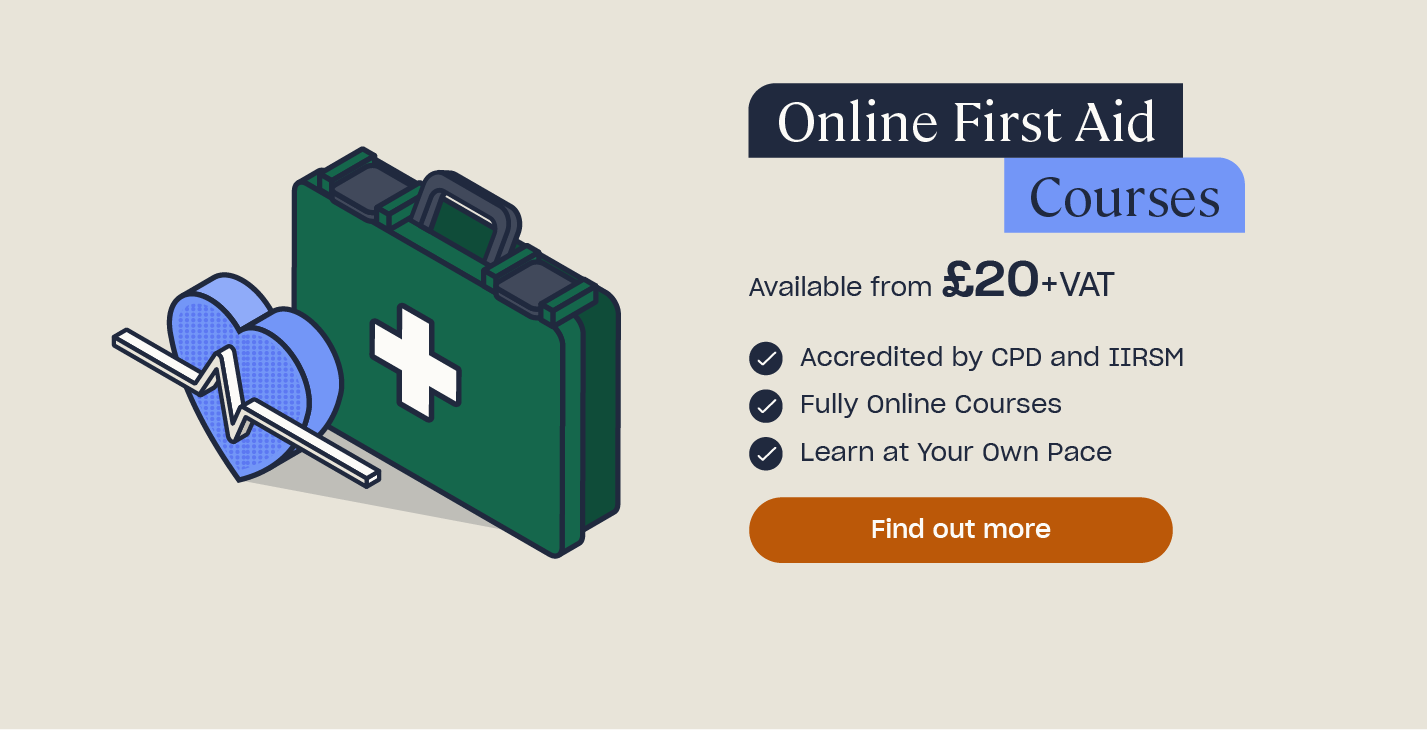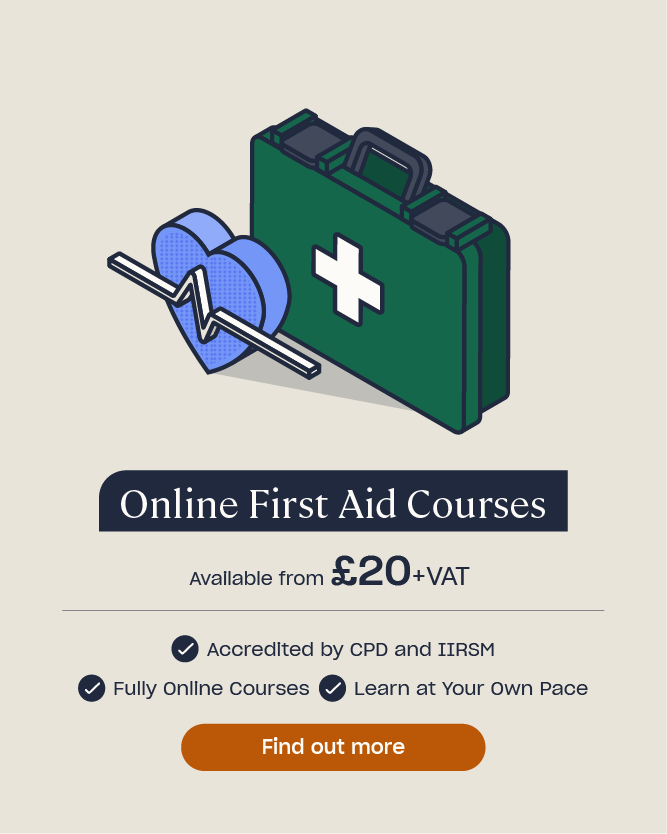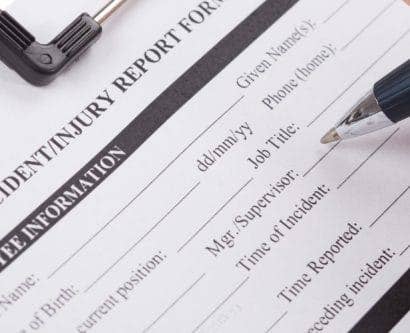First Aid Qualifications: The Difference Between FAW and EFAW
The Health and Safety (First-Aid) Regulations 1981 (the First Aid Regulations) refer to first aid as the treatment given to someone to preserve their life and minimise the consequences of injury and illness until help from a medical practitioner or nurse is obtained, and; the treatment of minor injuries which would otherwise receive no treatment or which don’t need treatment by a medical practitioner or nurse.
A first aid qualification will give you the knowledge needed to confidently respond to a wide range of medical situations. This includes those that require life-saving first aid assistance, such as a casualty in cardiac arrest needing CPR urgently. There are two types of first aid qualification – First Aid at Work (FAW) and Emergency First Aid at Work (EFAW). This article will explain the difference between these two first aid qualifications and when each is required, depending on the workplace.
Looking to gain first aid skills?
Our Workplace First Aid course is essential for everyone in every workplace and every home. You never know when you may need to use first aid skills and have the confidence to act in a potentially life-threatening situation.
What’s the Importance of First Aid Training?
First aid training is important because it gives people the skills needed to help someone who requires medical assistance. This assistance can be crucial to an individual’s survival if their illness or injury is time critical and requires immediate treatment. For example, if someone is losing a lot of blood due to an injury, the bleeding needs to be stopped as soon as possible. The casualty cannot be left unattended until the emergency services arrive, as by this time they could have lost a lot of blood, developed shock, or become unresponsive. First aiders, therefore, play a key role in attending to casualties before paramedics can arrive and take over. They are also required to treat accidents and incidents that don’t require professional medical assistance, such as minor burns and scalds.
Legal Requirements
Under the First-Aid Regulations, all employers must provide adequate and appropriate first aid equipment, facilities, and personnel. This ensures that employees receive immediate assistance if they are injured or taken ill at work. What is deemed both ‘adequate and appropriate’ depends on the hazards and risks of the particular workplace and work activities. To determine this, employers must carry out a first aid needs assessment (or arrange for one to be carried out on their behalf).
If the outcome of the needs assessment shows that a first aider is required, then employers must ensure that the required number of people undertake the appropriate first aid training qualification. This will make them either a first aider, or an emergency first aider.
As well as helping to save lives and treat illnesses and injuries, first aid training is important to ensure that employers are adhering to their legal duties.

What are the Differences Between First Aid at Work and Emergency First Aid at Work Courses?
There are two types of first aid qualification that certify someone as a first aider: First Aid at Work (FAW) and Emergency First Aid at Work (EFAW). First Aid at Work is a Level 3 qualification, while Emergency First Aid at Work is classed as a Level 2 qualification.
Similarities Between FAW and EFAW
Both FAW and EFAW Training must include a practical training element. They can, however, include an e-learning component as well as face to face training – this is known as blended learning. If a blended learning course is selected, employers must carry out the necessary additional checks to ensure that it is suitable.
On completion of either training course, the individual will be certified as a qualified first aider. They will have been assessed as having the skills and capabilities to carry out first aid assistance. Specifically, this means that they can give rescue breaths during CPR to a casualty who isn’t breathing normally, whereas those who aren’t qualified are advised to give hands-only CPR.
Requalification training must take place every three years. It is also recommended that first aiders undergo annual refresher training between qualifications. Annual refresher training doesn’t need to involve in-person training. Instead, an online course may be suitable, such as High Speed Training’s First Aid at Work (FAW) Refresher or Emergency First Aid at Work (EFAW) Refresher courses.
What is an Emergency First Aid at Work Course?
An Emergency First Aid at Work training course (EFAW training) is described by the Health and Safety Executive (HSE) as training that ‘enables a first-aider to give emergency first aid to someone who is injured or becomes ill while at work’. It includes fewer topics than the FAW course, and is designed to qualify trainers to respond confidently to emergency medical situations.
On completion of EFAW training, the individual must be able to:
- Understand the role of the first-aider, including reference to:
- The importance of preventing cross infection.
- The need for recording incidents and actions.
- The use of available equipment.
- Assess the situation and circumstances in order to act safely, promptly and effectively in an emergency.
- Administer first aid to a casualty who is unconscious (including seizure).
- Administer cardiopulmonary resuscitation and use an automated external defibrillator.
- Administer first aid to a casualty who is choking.
- Administer first aid to a casualty who is wounded and bleeding.
- Administer first aid to a casualty who is suffering from shock.
- Provide appropriate first aid for minor injuries (including small cuts, grazes and bruises, minor burns and scalds, small splinters).
EFAW training courses must involve at least six hours of training and run over a minimum of one day (including the assessment). Note that to remain a first aider, requalification training must be taken every three years. This must cover the same topics as the initial EFAW qualification, and be the same minimum duration (at least six hours over a minimum of one day).

What is a First Aid at Work Course?
A First Aid at Work (FAW) training course is described by the Health and Safety Executive (HSE) as meeting the same requirements as EFAW training but it ‘also equips the first-aider to apply first aid to a range of specific injuries and illnesses’. It is more extensive than the EFAW training course, and is designed to qualify trainers to respond to a range of situations, not just ones which are classed as emergencies.
The HSE states that, on completion of FAW training, the individual must be able to demonstrate competence in all of the subject areas listed for EFAW training (see above), as well as be able to:
- Administer first aid to a casualty with:
- Injuries to bones, muscles and joints, including suspected spinal injuries.
- Chest injuries.
- Burns and scalds.
- Eye injuries.
- Sudden poisoning.
- Anaphylactic shock.
- Recognise the presence of major illness (including heart attack, stroke, epilepsy, asthma, diabetes) and provide appropriate first aid.
FAW courses must involve at least 18 hours of training and run over a minimum of three days (including the assessment). As with the EFAW qualification, to remain a first aider, FAW requalification training must be taken every three years. This must cover the same topics as the initial FAW qualification, and must be at least 12 hours over a minimum of two days.
Which First Aid Qualification is Best Suited to my Role?
It is the employer’s duty to ensure that they have sufficient first aid ‘personnel’ at their premises. As explained, this involves carrying out a first aid needs assessment to determine what level of provision is required.
For a workplace where there are low-level hazards, such as an office, and where there’s also a small number of staff present (fewer than 25), a first aider may not be required. Instead, an appointed person may provide sufficient cover. You can find out more about the role of the appointed person in our article ‘How Many First Aiders Do I Need In My Workplace?’. The majority of workplaces, however, will need to have someone who is a qualified first aider, in either FAW or EFAW.
It’s important to remember that the level of first aid qualification needed is dependent on the employer’s first aid needs assessment. If you are an employee and have any queries about what first aid qualification you need, you should speak to your employer. We recommend that employers consult the HSE’s guidance if further information on the requirements for first aiders at work is required:
Low-Level Hazards
To find out whether your workplace has low or higher level hazards, you can consult the workplace risk assessment which will make this clear.
If the workplace has low-level hazards, you then need to consider how many employees are present. For 25-50 people employed, there must be at least one person holding an Emergency First Aid at Work (EFAW) qualification. If there are more than 50 employees, then the First Aid at Work (FAW) qualification will be required instead. There must be at least one FAW trained person for every 100 people employed.
If there are less than 25 employees at a workplace with low-level hazards, a first aider may not be needed and an appointed person may be sufficient.
Examples of Low-Level Hazard Workplaces
Offices and shops will likely be classed as having low-level hazards. Often, there won’t be any hazards, such as machinery, that could put people at serious risk of harm should something go wrong in these types of work environments. Examples of possible roles in a low-level hazard workplace include retail workers, librarians, office workers, and administrative staff.
It is likely that schools, early years, and colleges would also be classed as having low-level hazards. Guidance published by the Department for Education acknowledges that the First-Aid Regulations don’t require employers to provide first aid for anyone other than their employees, but it’s strongly recommended that the needs of non-employees, such as pupils, students and visitors, are considered. Employers may decide to consider the number of people, as opposed to just the number of employees, when making their first aid needs assessment. The Department for Education also states that this assessment will likely identify that at least one first aider is required.
Whether they need to be trained in FAW or EFAW will depend on the circumstances of each individual school or college. All employees, and especially teachers, should have an awareness of first aid. This ensures that they know how to react if a child in their care falls ill or sustains an injury. Ultimately, employers are best placed to understand the hazards at their workplace and will determine what level of first aid knowledge is required for their employees.

Higher-Level Hazards
Higher-level hazards are those which are present in the work environment that could cause someone serious harm. As the conditions in workplaces with higher-level hazards mean that more serious injuries can occur, the level of first aid provision required is higher.
If there are fewer than five employees, at least one appointed person may be suitable. For five to 50 employees, at least one first aider trained in EFAW or FAW will be required, depending on the type of injuries that might occur. If the potential injuries are severe, then FAW will be required. If more than 50 people are employed, at least one first aider trained in FAW is needed for every 50 employees. For example, if there are 150 employees, then three first aiders qualified in FAW will be required.
Examples of Higher-Level Hazard Workplaces
The HSE lists the following examples of higher-level hazard workplaces: premises where light engineering and assembly work, food processing, warehousing, extensive work with dangerous machinery or sharp instruments, construction, or chemical manufacturing takes place. These types of work activities involve equipment, machinery, or work conditions that can result in very serious injuries if something goes wrong.
Examples of workplaces with higher-level hazards that may result in injury include: a construction site where someone has failed to carry out a work activity in the correct, safe way, and so fallen from height and suffered from a serious head injury; or, a chemical manufacturing site where someone has failed to wear the correct personal protective equipment (PPE) when handling chemicals and has got chemicals in their eyes.
Restaurants and other industries within the hospitality sector may be classed as having higher-level hazards. For example, due to the nature of the work people could sustain burns or scalds, cuts from knife injuries, or a customer may experience an allergic reaction. As there is a potential for this level of harm to occur due to the work activities, it’s likely that at least one employee will need to be a qualified first aider.

It’s considered best practice for all employees to be provided with a knowledge of first aid, both in workplaces with low and higher-level hazards. If someone isn’t a first aider and so doesn’t need to undergo training that makes them qualified, they will likely benefit from first aid awareness training instead. This doesn’t give them a qualification or make them a first aider, but it will provide them with the skills required to respond to a casualty in need.
High Speed Training offers a range of awareness level courses that may be suitable for this purpose, including Workplace First Aid, Paediatric First Aid, and CPR Awareness.
Anyone is able to become a first aider if they want to, they just need to undergo suitable practical first aid training. If you want to become a qualified first aider, there are a range of training providers available who should offer what you need. To find out more about what responsibilities first aiders have, you can look at our dedicated article.
No matter which of the first aid qualifications you decide to gain, both FAW and EFAW will give you the knowledge and skills needed to respond to emergency situations. The key difference between them is that FAW is more extensive and includes how to treat a wider range of illnesses and injuries.
Further Resources
- Online FAW Refresher Training
- Online EFAW Refresher Training
- How to Conduct a First Aid Needs Assessment: Free Template
- First Aid Kit Guidance: What Does My Workplace Need?
- How to Support Individuals After Giving First Aid Assistance











